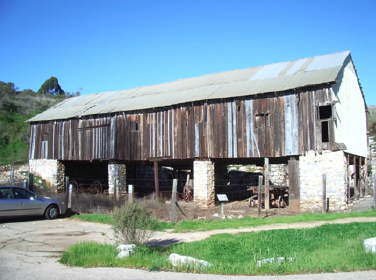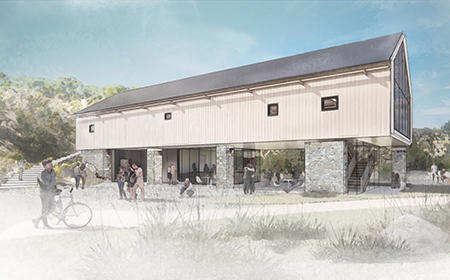A generous anonymous gift is helping UC Santa Cruz honor its history, reimagine the entrance to campus, and create a unique meeting and event space for the campus and the greater community.
The generous gift is intended to lead and jumpstart fundraising to support the rehabilitation of what is known as the Cowell Ranch Cooperage, one of the oldest buildings on the UC Santa Cruz campus. Built in 1869, the cooperage was originally used to construct and house wooden barrels for storing and shipping lime, heated from quarried limestone in the adjacent limekilns. The building has undergone several iterations in its 155-year lifespan, including when it was shortened to make way for Coolidge Drive, which became the main entrance to campus. It is believed to be the only remaining free-standing cooperage in California.
Similar to the renovation of the nearby Cowell Ranch Hay Barn, the cooperage project will involve rehabilitating the building, consistent with its historical significance, while also reimagining it for everyday use by the campus and broader community. Along with the hay barn, it will be an important anchor building for what is known as the gateway area to campus. Unlike the hay barn, the cooperage was constructed as a “bridge truss” rather than as a traditional building. Workers did their barrel work not only inside the structure but beneath it. It is obvious how the building has been reinforced over time to keep the structure intact.
When rehabilitated, the new building will be multi-use and be an important venue for campus and community engagement. It may include event and lecture space, a small coffee shop, and open collaboration areas. While the space will be an important asset to the entire campus, it will be stewarded by the administrative offices of the UC Santa Cruz Foundation and the Alumni Association.
The cooperage is in the Cowell Lime Works Historic District, which was added to the National Register of Historic Places in 2007. The general revitalization of the area represents UC Santa Cruz’s commitment to preserving history, honoring the original inhabitants of the land—the Awaswas-speaking Uypi Tribe—and those who followed, and reimagining the spaces for present-day use. While the building will represent a certain point in time, the campus plans to have the surrounding landscape honor earlier times. Planning remains in the early stages.
Chancellor Cynthia Larive said she is excited by the latest historic district project, calling it a sure-to-be “showstopper” at the gateway to campus.
“The hay barn project showed us the potential for that area. The cooperage builds on that, allowing us to preserve and showcase the fascinating history of the campus landscape while also creating a multipurpose space that serves our mission of teaching, research, and public service,” Larive said. “Its unique location also makes it an ideal gathering space for both the community and campus. These kinds of spaces are vital for town-and-gown engagement.”
The cooperage project was outlined in broad strokes in the 2021 Long Range Development Plan, which integrates the academic mission of UC Santa Cruz with environmental stewardship and sustainable growth strategies. The project embodies the concepts outlined in the Historic District and Campus Gateway Visioning Study, conducted in 2021-2022, to revitalize the campus gateway with rehabilitated buildings, landscapes, and circulation for the campus and community. This study was stewarded by a campus committee led by co-chairs Jasmine Alinder, dean of the Humanities Division and Tony Cobb, associate vice chancellor of Physical Planning, Development, and Operations. A separate Cooperage Programming and Building Committee, chaired by John D. Pine, assistant vice chancellor for alumni engagement, is helping to guide the cooperage’s rehabilitation and future use. This committee includes representation from the Friends of the Cowell Lime Works.
Jensen Architects was selected for the project design. The Bay Area firm is known for practicing at the confluence of art, architecture, and building technology, and collaborating with clients to create buildings and environments in dialogue with culture and place.
“Our goal is to treat this treasured resource with respect and to infuse the rehabilitation with the atmosphere derived from layers of past occupancy of the site,” says Mark Jensen, principal with Jensen Architects. “Reusing the historical building’s material and form, the cooperage rehabilitation creates a flexible, low-carbon, community-focused space rooted in history and landscape.”
The generous lead gift provides initial funding for building construction, which is anticipated to begin in late 2024 and completed by early 2026. Additional private support is being sought for various facets of the project. To learn more about how to give to the cooperage revitalization project, contact Mark Delos Reyes Davis, Vice Chancellor of University Advancement, at mdrdavis@ucsc.edu.





